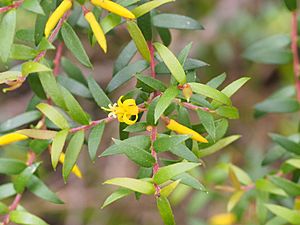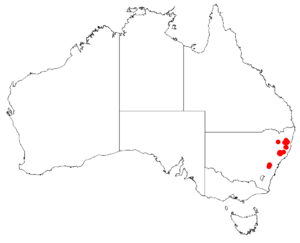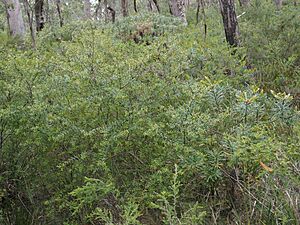Persoonia acuminata facts for kids
Quick facts for kids Persoonia acuminata |
|
|---|---|
 |
|
| Persoonia acuminata foliage and flowers | |
| Scientific classification | |
| Genus: |
Persoonia
|
| Species: |
acuminata
|
 |
|
| Occurrence data from Australasian Virtual Herbarium | |
Persoonia acuminata is a special plant found only in New South Wales, Australia. It belongs to the Proteaceae plant family. This plant is a shrub that can spread out or grow low to the ground. It has small leaves and bright yellow, tube-shaped flowers. These flowers grow alone or in groups of up to sixteen. You can find them where leaves join the stem or at the ends of branches. Persoonia acuminata likes to grow in damp forests in higher areas called tablelands.
What Persoonia acuminata Looks Like
Persoonia acuminata is a shrub that can grow up to about 1.7 meters (5.6 feet) tall. Its young branches have some hairs, but its bark is smooth. The leaves are flat and shaped like a wide oval or an egg. They are about 8 to 22 millimeters (0.3 to 0.9 inches) long. They are also about 2.5 to 8.5 millimeters (0.1 to 0.3 inches) wide. Each leaf has a pointed tip.
When the leaves are young, they have a few hairs. But as they get older, they usually become smooth. The top side of the leaf is much darker than the bottom side.
The flowers are yellow. They grow alone or in groups of up to sixteen. You can find them where leaves meet the stem, called leaf axils. They also grow at the ends of the branches. Each flower has a smooth stem, called a pedicel, which is about 3 to 6 millimeters (0.1 to 0.2 inches) long.
Each flower has four parts called tepals. These tepals are 7 to 10 millimeters (0.3 to 0.4 inches) long. They are joined at the bottom, but their tips curl backward. In the center of the flower is a style. This style is surrounded by four yellow anthers. The anthers are also joined at their base, and their tips curl back. This makes the flower look like a cross when you look at it from the end. The part of the flower that holds the seeds, called the ovary, is smooth. The outside of the tepals are also smooth.
Persoonia acuminata flowers from December to April. After flowering, it produces green fruits. These fruits are called drupes, which are like small stone fruits.
How Persoonia acuminata Got Its Name
The plant Persoonia acuminata was first officially described in 1991. Two scientists, Lawrie Johnson and Peter Weston, described it. They found a sample of the plant in Werrikimbe National Park. Their description was published in a science magazine called Telopea.
The second part of the plant's name, acuminata, is a Latin word. It means "pointed" or "sharpened." This name was chosen because the leaves of this plant have pointed tips.
Where Persoonia acuminata Lives
This type of Persoonia plant grows in different kinds of forests. It can be found in open heathlands or wet forests. It prefers soil that comes from granite, basalt, or metasedimentary rock. It does not grow in sandy soil.
You can find this plant in separate areas. Some groups of plants are in the Ebor and Barrington Tops regions. These areas are part of the New England Tableland. Other groups are in the Hampton district, which is on the Central Tablelands. Persoonia acuminata grows at high places, usually between 1000 and 1500 meters (3,300 to 4,900 feet) above sea level.


